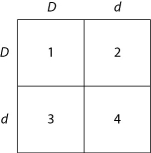Use Figure 14.1 and the following description to answer the questions below.
In a particular plant, leaf color is controlled by gene locus D. Plants with at least one allele D have dark green leaves, and plants with the homozygous recessive dd genotype have light green leaves. A true-breeding dark-leaved plant is crossed with a light-leaved one, and the F₁ offspring is allowed to self-pollinate. The predicted outcome of the F₂ is diagrammed in the Punnett square shown in Figure 14.1, where 1, 2, 3, and 4 represent the genotypes corresponding to each box within the square.

Figure 14.1
-Which of the boxes marked 1-4 correspond to plants with dark leaves?
Definitions:
Dissociative Amnesia
A psychological condition characterized by temporary loss of memory regarding personal information, usually due to trauma or stress.
Panic Disorder
A mental health condition characterized by sudden and repeated episodes of intense fear or discomfort, known as panic attacks, often without apparent cause.
Dissociative Fugue
A rare dissociative disorder characterized by temporary amnesia for personal identity, including memories, personality, and other identifying characteristics.
Anterograde Amnesia
A condition affecting memory, inhibiting the ability to form new memories after the event that caused the amnesia.
Q24: Which of the following occurs in meiosis
Q28: What is the purpose of beta oxidation
Q37: If she moves the promoter for the
Q46: During cellular respiration, acetyl CoA accumulates in
Q49: Since the spaceship will be too far
Q50: Carbon dioxide (CO₂)is released during which of
Q67: In the human species, all somatic cells
Q68: In which of the following ways do
Q81: Transcription factors in eukaryotes usually have DNA
Q86: Carbon skeletons for amino acid biosynthesis are